Page 2523 of 5267
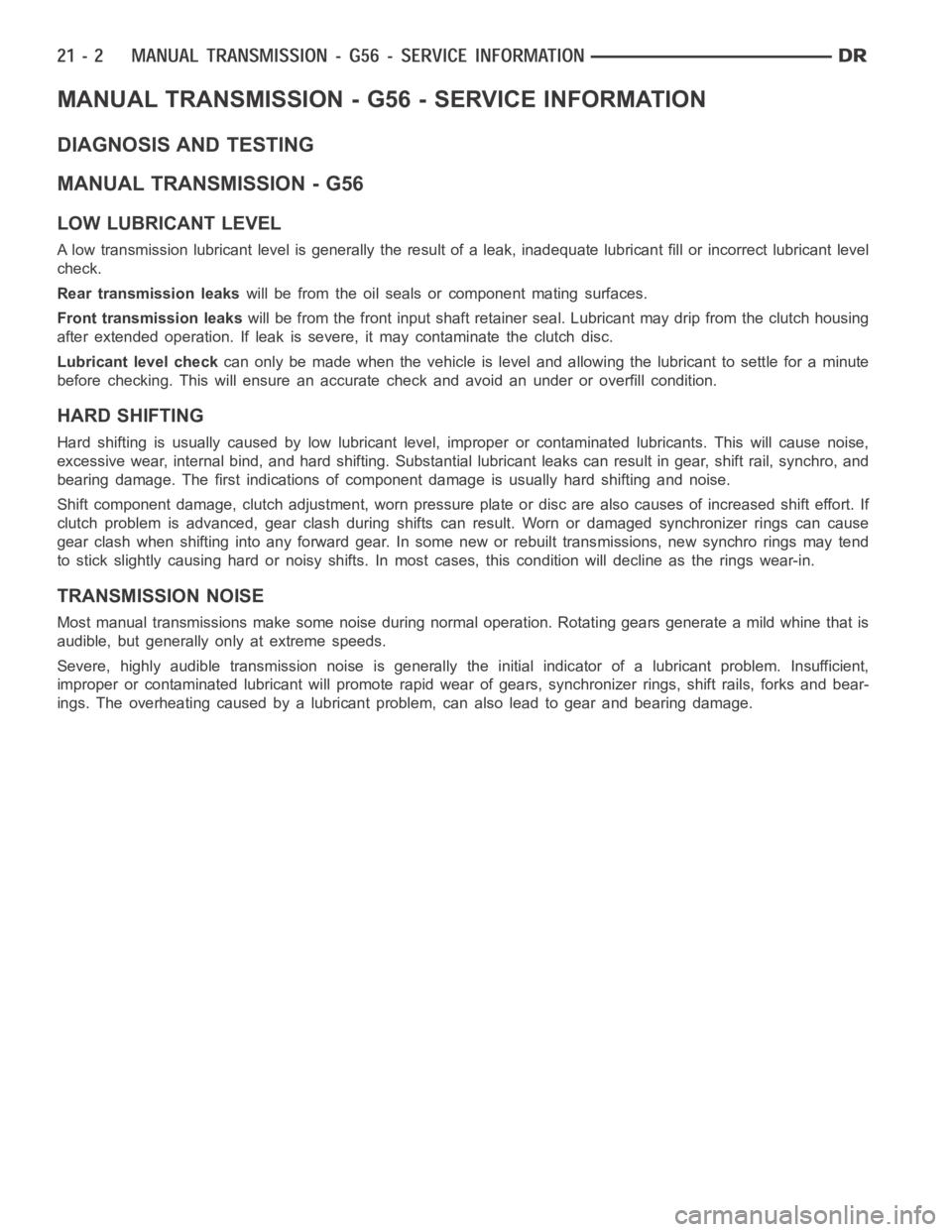
MANUAL TRANSMISSION - G56 - SERVICE INFORMATION
DIAGNOSIS AND TESTING
MANUAL TRANSMISSION - G56
LOW LUBRICANT LEVEL
A low transmission lubricant level is generally the result of a leak, inadequate lubricant fill or incorrect lubricant level
check.
Rear transmission leakswill be from the oil seals or component mating surfaces.
Front transmission leakswill be from the front input shaft retainer seal. Lubricant may drip from theclutchhousing
after extended operation. If leak is severe, it may contaminate the clutchdisc.
Lubricant level checkcan only be made when the vehicle is level and allowing the lubricant to settle for a minute
before checking. This will ensure an accurate check and avoid an under or overfill condition.
HARD SHIFTING
Hard shifting is usually caused by low lubricant level, improper or contaminated lubricants. This will cause noise,
excessive wear, internal bind, and hard shifting. Substantial lubricantleaks can result in gear, shift rail, synchro, and
bearing damage. The first indications of component damage is usually hardshifting and noise.
Shift component damage, clutch adjustment, worn pressure plate or disc are also causes of increased shift effort. If
clutch problem is advanced, gear clash during shifts can result. Worn or damaged synchronizer rings can cause
gear clash when shifting into any forward gear. In some new or rebuilt transmissions, new synchro rings may tend
to stick slightly causing hard or noisy shifts. In most cases, this condition will decline as the rings wear-in.
TRANSMISSION NOISE
Most manual transmissions make some noise during normal operation. Rotating gears generate a mild whine that is
audible, but generally only at extreme speeds.
Severe, highly audible transmission noise is generally the initial indicator of a lubricant problem. Insufficient,
improper or contaminated lubricant will promote rapid wear of gears, synchronizer rings, shift rails, forks and bear-
ings. The overheating caused by a lubricant problem, can also lead to gear and bearing damage.
Page 2544 of 5267
COUNTERSHAFT
NOTE: Bearings are the only component serviced
on the countershaft.
1. Remove countershaft rear housing bearing with
Puller 6444 (1), Plug 8513A (2), Puller Jaws 9597
(3) , Puller Collar 6444-8 (4), Puller Rods 6444-3
and Puller Flange 6444-1. Position Puller Jaws
9597 around bearing and puller flange. Position
puller collar around the puller jaws. Tighten the
puller bolt and remove countershaft bearing.
2. Remove countershaft first/reverse gear bearing oil
slinger from countershaft.
3. Remove countershaft front housing bearing with
Puller 6444 (1), Puller Collar 6444-8 (2), Puller
Jaws 9597 (3), Puller Rods 6444-3 and Puller
Flange 6444-1. Position puller jaws around bearing
and puller flange. Position puller collar around the
puller jaws. Tighten the puller bolt and remove
countershaft bearing.
Page 2549 of 5267
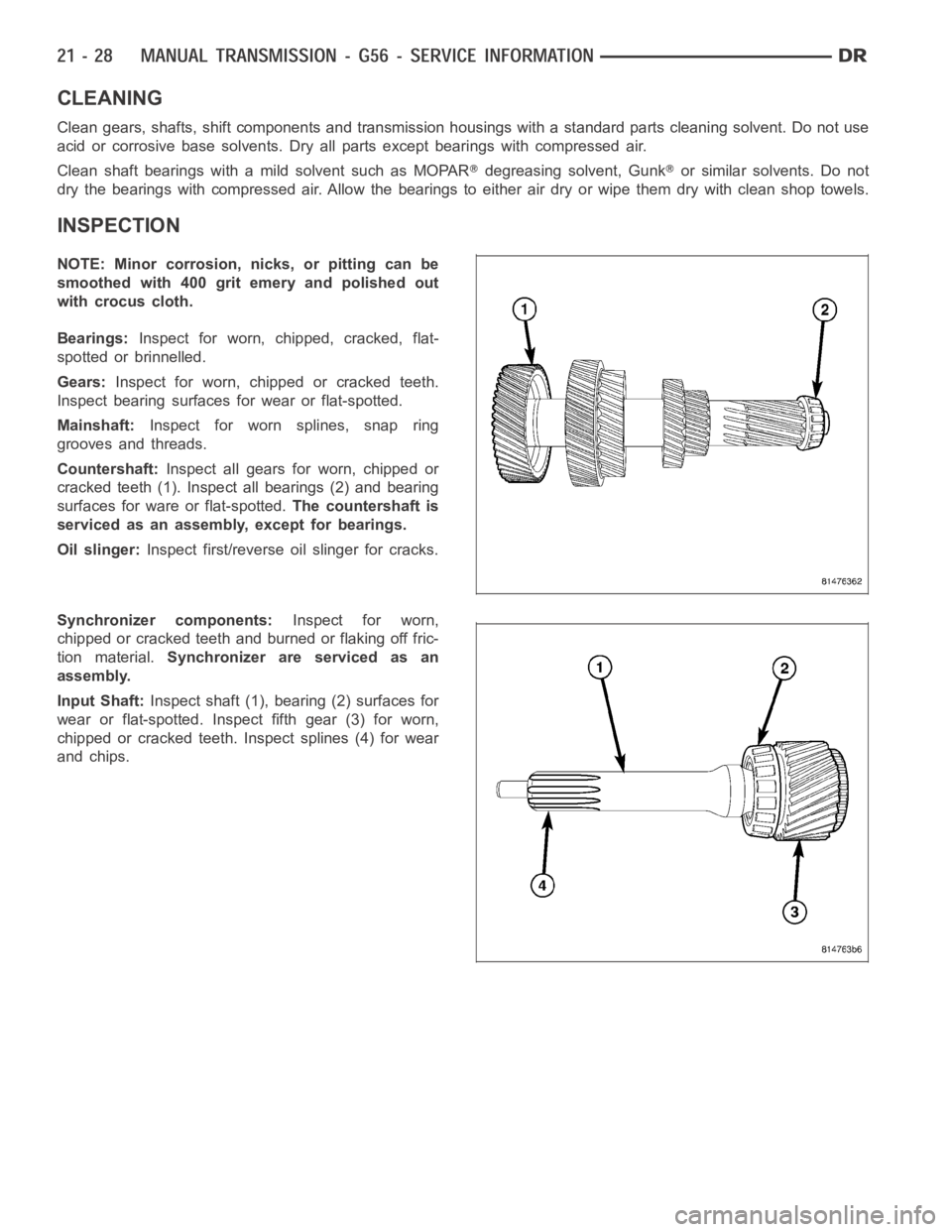
CLEANING
Clean gears, shafts, shift components and transmission housings with a standard parts cleaning solvent. Do not use
acid or corrosive base solvents. Dry all parts except bearings with compressed air.
Clean shaft bearings with a mild solvent such as MOPAR
degreasing solvent, Gunkor similar solvents. Do not
dry the bearings with compressed air. Allow the bearings to either air dry or wipe them dry with clean shop towels.
INSPECTION
NOTE: Minor corrosion, nicks, or pitting can be
smoothed with 400 grit emery and polished out
with crocus cloth.
Bearings:Inspect for worn, chipped, cracked, flat-
spotted or brinnelled.
Gears:Inspect for worn, chipped or cracked teeth.
Inspect bearing surfaces for wear or flat-spotted.
Mainshaft:Inspect for worn splines, snap ring
grooves and threads.
Countershaft:Inspect all gears for worn, chipped or
cracked teeth (1). Inspect all bearings (2) and bearing
surfaces for ware or flat-spotted.The countershaft is
serviced as an assembly, except for bearings.
Oil slinger:Inspect first/reverse oil slinger for cracks.
Synchronizer components:Inspect for worn,
chipped or cracked teeth and burned or flaking off fric-
tion material.Synchronizer are serviced as an
assembly.
Input Shaft:Inspect shaft (1), bearing (2) surfaces for
wear or flat-spotted. Inspect fifth gear (3) for worn,
chipped or cracked teeth. Inspect splines (4) for wear
and chips.
Page 2550 of 5267
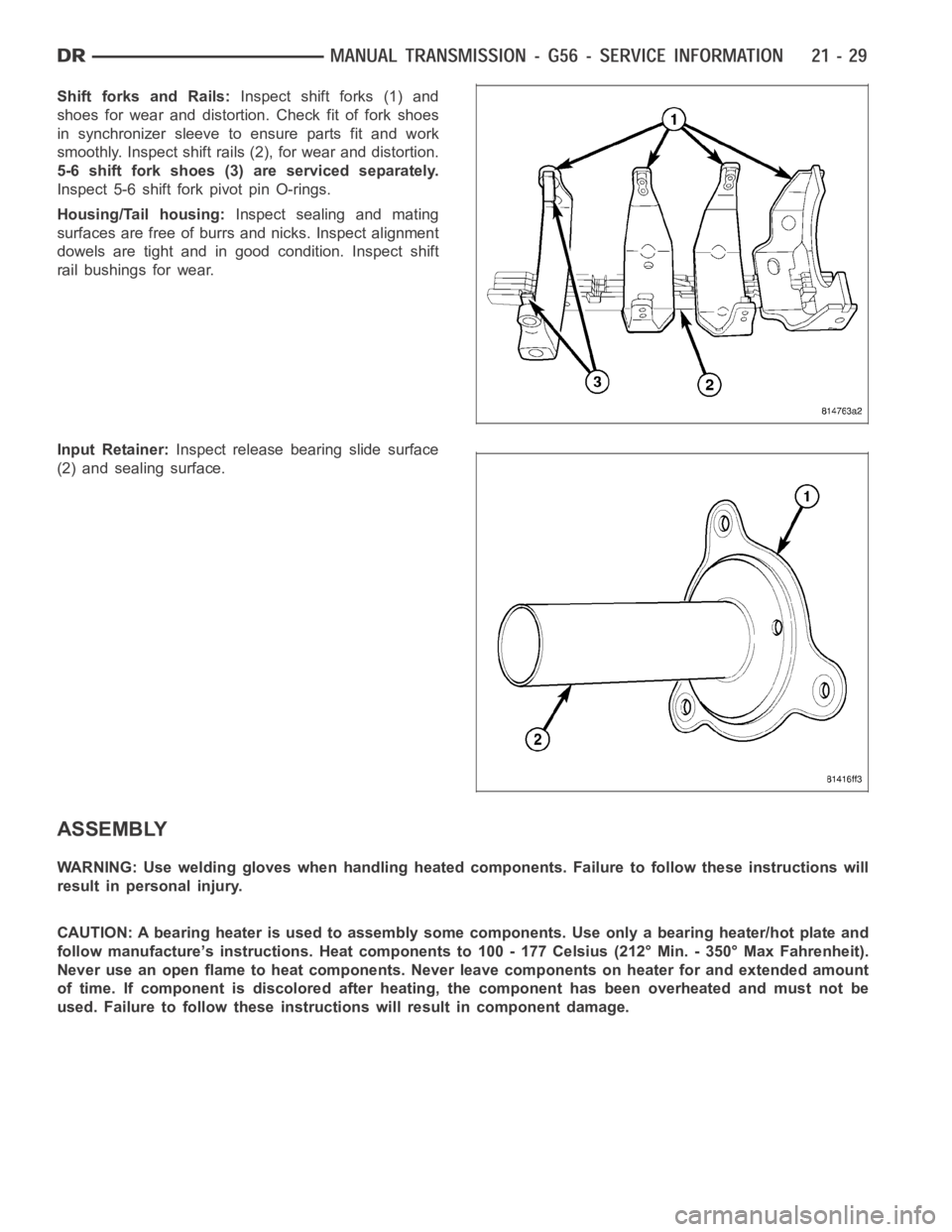
Shift forks and Rails:Inspect shift forks (1) and
shoes for wear and distortion. Check fit of fork shoes
in synchronizer sleeve to ensure parts fit and work
smoothly. Inspect shift rails(2), for wear and distortion.
5-6 shift fork shoes (3) are serviced separately.
Inspect 5-6 shift fork pivot pin O-rings.
Housing/Tail housing:Inspect sealing and mating
surfaces are free of burrs and nicks. Inspect alignment
dowels are tight and in good condition. Inspect shift
rail bushings for wear.
Input Retainer:Inspect release bearing slide surface
(2) and sealing surface.
ASSEMBLY
WARNING: Use welding gloves when handling heated components. Failure to follow these instructions will
result in personal injury.
CAUTION:Abearingheaterisusedtoassemblysomecomponents.Useonlyabearing heater/hot plate and
follow manufacture’s instructions. Heat components to 100 - 177 Celsius (212° Min. - 350° Max Fahrenheit).
Never use an open flame to heat components. Never leave components on heater for and extended amount
of time. If component is discolored after heating, the component has been overheated and must not be
used. Failure to follow these instructions will result in component damage.
Page 2591 of 5267
page page
MANUAL TRANSMISSION - GETRAG 238 -
SERVICE INFORMATION
DIAGNOSIS AND TESTING
MANUAL TRANSMISSION - GETRAG 238 . . . . . 71
STANDARD PROCEDURE
DRAIN AND FILL ............................ 71
REMOVAL .................................... 72
DISASSEMBLY ............................... 74CLEANING .................................. 100
INSPECTION . . .............................. 100
ASSEMBLY .................................. 103
INSTALLATION .............................. 135
SPECIFICATIONS
MANUAL TRANSMISSION - GETRAG 238 . . . . 136
SPECIAL TOOLS ............................ 138
Page 2592 of 5267
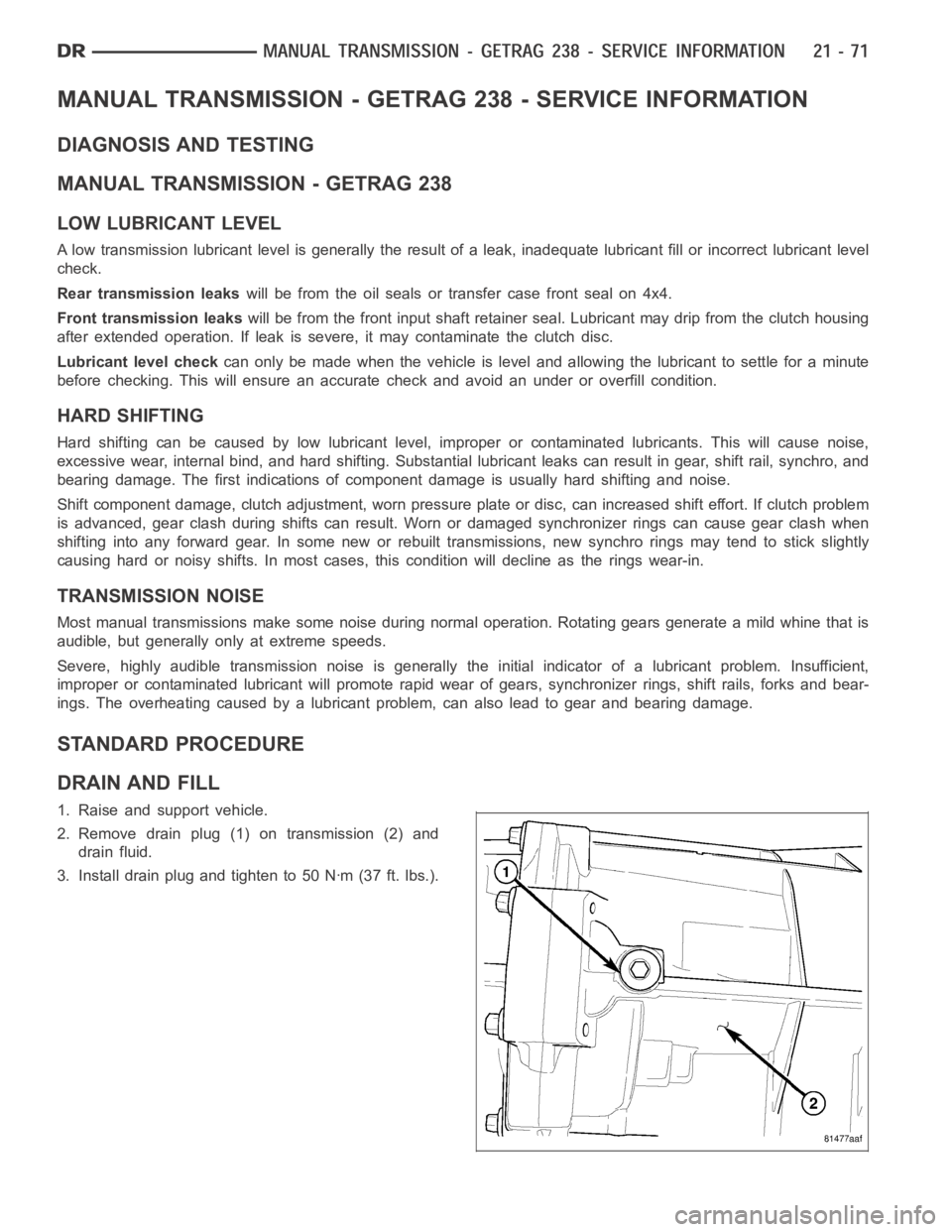
MANUAL TRANSMISSION - GETRAG 238 - SERVICE INFORMATION
DIAGNOSIS AND TESTING
MANUAL TRANSMISSION - GETRAG 238
LOW LUBRICANT LEVEL
A low transmission lubricant level is generally the result of a leak, inadequate lubricant fill or incorrect lubricant level
check.
Rear transmission leakswill be from the oil seals or transfer case front seal on 4x4.
Front transmission leakswill be from the front input shaft retainer seal. Lubricant may drip from theclutchhousing
after extended operation. If leak is severe, it may contaminate the clutchdisc.
Lubricant level checkcan only be made when the vehicle is level and allowing the lubricant to settle for a minute
before checking. This will ensure an accurate check and avoid an under or overfill condition.
HARD SHIFTING
Hard shifting can be caused by low lubricant level, improper or contaminated lubricants. This will cause noise,
excessive wear, internal bind, and hard shifting. Substantial lubricantleaks can result in gear, shift rail, synchro, and
bearing damage. The first indications of component damage is usually hardshifting and noise.
Shift component damage, clutch adjustment, worn pressure plate or disc, can increased shift effort. If clutch problem
is advanced, gear clash during shifts can result. Worn or damaged synchronizer rings can cause gear clash when
shifting into any forward gear. In some new or rebuilt transmissions, new synchro rings may tend to stick slightly
causing hard or noisy shifts. In most cases, this condition will decline asthe rings wear-in.
TRANSMISSION NOISE
Most manual transmissions make some noise during normal operation. Rotating gears generate a mild whine that is
audible, but generally only at extreme speeds.
Severe, highly audible transmission noise is generally the initial indicator of a lubricant problem. Insufficient,
improper or contaminated lubricant will promote rapid wear of gears, synchronizer rings, shift rails, forks and bear-
ings. The overheating caused by a lubricant problem, can also lead to gear and bearing damage.
STANDARD PROCEDURE
DRAIN AND FILL
1. Raise and support vehicle.
2. Remove drain plug (1) on transmission (2) and
drain fluid.
3. Install drain plug and tighten to 50 Nꞏm (37 ft. lbs.).
Page 2621 of 5267
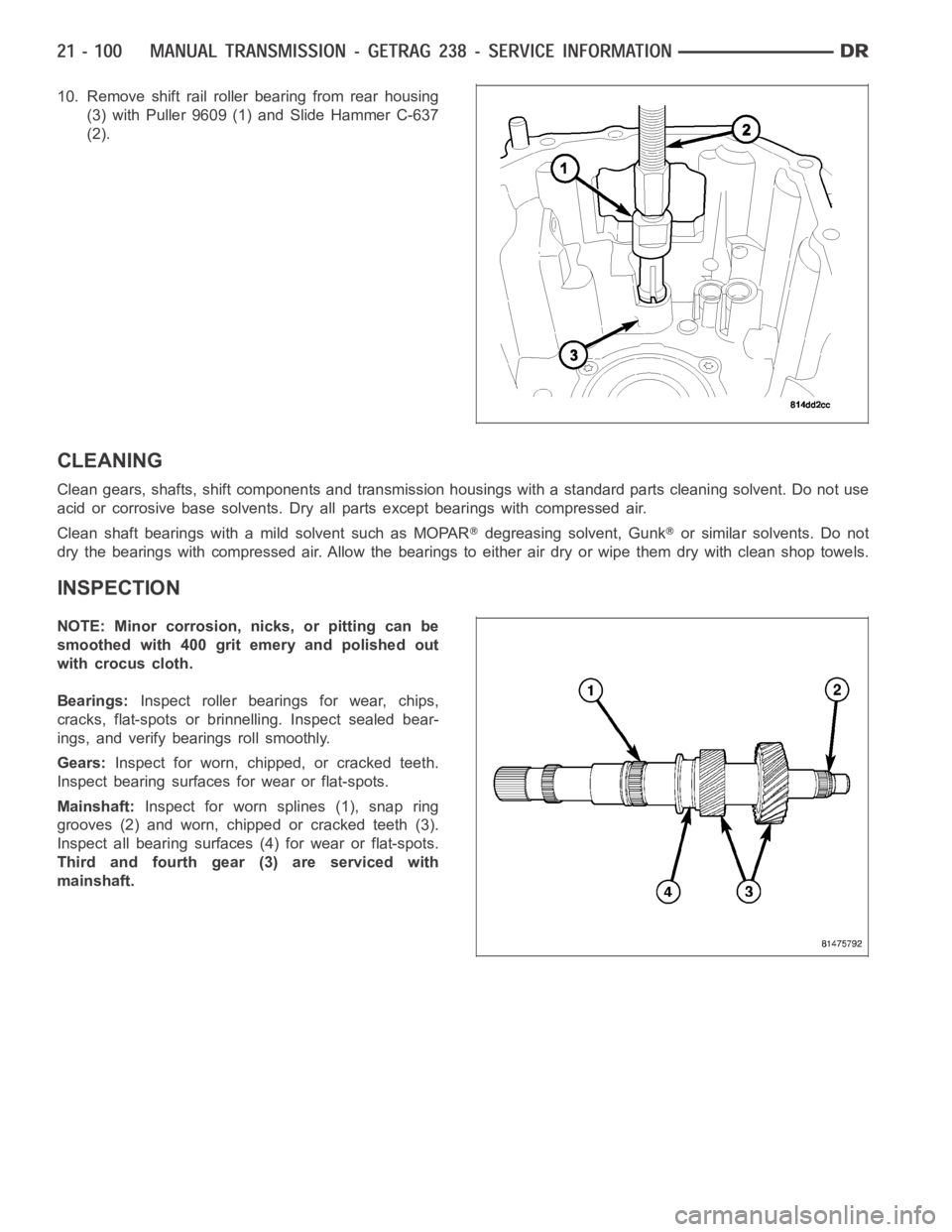
10. Remove shift rail roller bearing from rear housing
(3) with Puller 9609 (1) and Slide Hammer C-637
(2).
CLEANING
Clean gears, shafts, shift components and transmission housings with a standard parts cleaning solvent. Do not use
acid or corrosive base solvents. Dry all parts except bearings with compressed air.
Clean shaft bearings with a mild solvent such as MOPAR
degreasing solvent, Gunkor similar solvents. Do not
dry the bearings with compressed air. Allow the bearings to either air dry or wipe them dry with clean shop towels.
INSPECTION
NOTE: Minor corrosion, nicks, or pitting can be
smoothed with 400 grit emery and polished out
with crocus cloth.
Bearings:Inspect roller bearings for wear, chips,
cracks, flat-spots or brinnelling. Inspect sealed bear-
ings, and verify bearings roll smoothly.
Gears:Inspect for worn, chipped, or cracked teeth.
Inspect bearing surfaces for wear or flat-spots.
Mainshaft:Inspect for worn splines (1), snap ring
grooves (2) and worn, chipped or cracked teeth (3).
Inspect all bearing surfaces (4) for wear or flat-spots.
Third and fourth gear (3) are serviced with
mainshaft.
Page 2622 of 5267
Countershaft:Inspect all gears for worn, chipped or
cracked teeth (1). Inspect 3-4 synchronizer assembly
for wear (2). Inspect center support bearing surfaces
(3) for wear or flat-spots.The countershaft with 3-4
synchronizer is serviced as an assembly, except
for bearings.
Synchronizer components:Inspect for worn,
chipped, or cracked teeth and burned or flaking off
friction material.Synchronizers are serviced as an
assembly.
Input Shaft:Inspect input shaft bearing (1) and bear-
ing surfaces for wear or flat-spots. Inspect input shaft
splines (2) for wear. Inspect snap ring groove (3) for
wear. Inspect fifth gear (4) for worn, chipped, or
cracked teeth.
Shift forks:Inspect shift forks (1) for distortion.
Inspect fork shoes (2) for wear and fit shoes in syn-
chronizer sleeve to ensure parts fit and work smoothly.